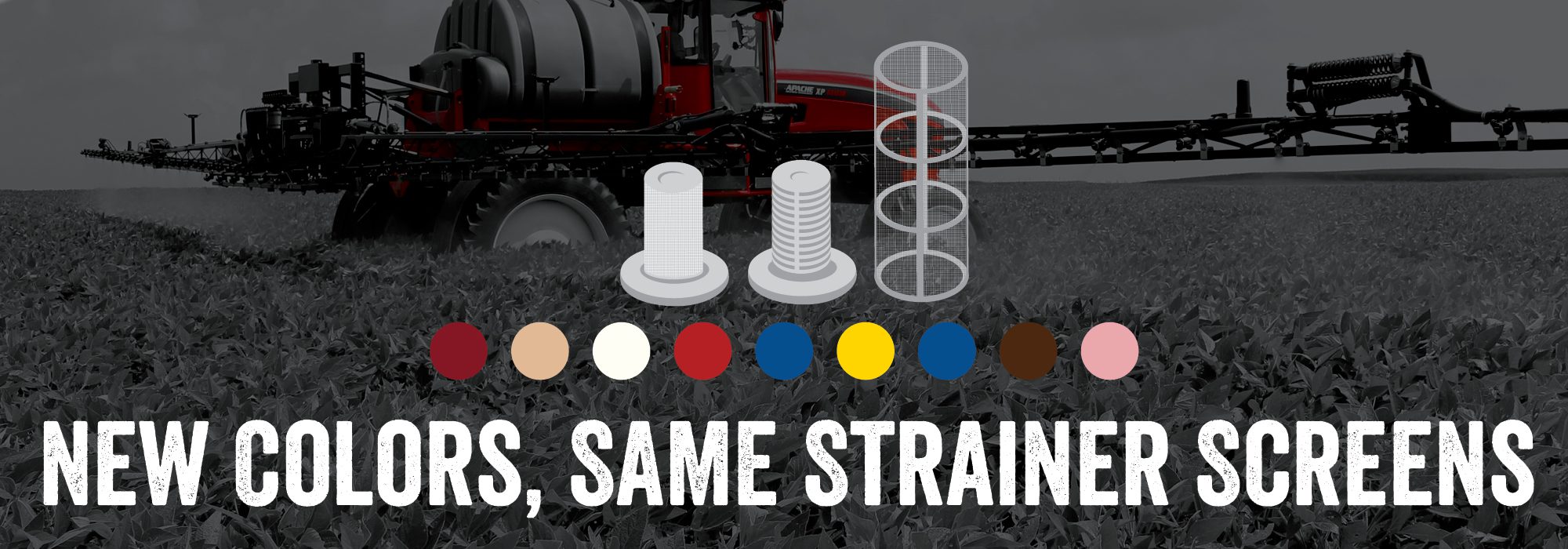
They’re small yet essential components of an Apache Sprayer, but a recent mandated change to strainer screen color-coding causing some big headaches for operators looking for the right replacement parts for their machines. But, not to worry: operators can look to their Apache specialists to find clarity on the recent change.
Effective August 2016, the International Organization for Standardization (ISO) implemented a universal color-coding system – ISO 19732 – for strainer screens across all manufacturers. Prior to the new standards, color coding varied by manufacturer, size, type and mesh size. The variation caused a lot of confusion for manufacturers, distributors and operators, says Equipment Technologies Application Parts Specialist Gary McKinney. And though the color code change has been around for more than a year, it’s still causing some angst among owners and operators.
“They all had their own color code systems for strainers, and nobody’s matched,” McKinney says. “This new ISO system with universal color codes is going to be good in the long term.”
Short-term Challenges
In the shorter term, the color change has caused issues for both operators and distributors called upon to fill their strainer screen needs, for a couple of reasons. First, it’s a change that some operators simply see as a hassle.
“Some operators have been reluctant, but others who are more accustomed to change have embraced the new color codes much more easily,” McKinney says. “They’re the same parts that operators are used to, just different colors.”
Inventory management challenges also arose once the ISO change went into effect. Some strainer screen manufacturers still have a lot of inventory from before the change went into effect. Moving inventory of both color schemes to customers sometimes creates confusion for operators replacing the parts on their sprayers.
“We still have old stock coming from a couple manufacturers and we’re seeing the new colors mixed in. That sometimes creates confusion for customers, but we can explain it and they get what they need. Manufacturers are doing a good job of marking the tip strainers with the mesh size, and that helps a great deal.”
Consistency on Its Way
How long will this mixed inventory situation last? It depends on the size and model of the strainer screen in question. More common sizes will be completely transitioned to the new color code system sooner than less common, more obscure sizes. At some point in the near future, McKinney expects the older inventory will likely be liquidated and all strainer screens available to customers will adhere to the new color coding system.
“Popular model numbers are pretty much sold down, but it looks like manufacturers are going to try to work through remaining inventory manufactured before the change,” he says. “It’s just what’s going on in the industry. We’ll get through it and we’ll continue to work with our customers to get through it.”
Replacing strainer screens
There’s no hard, fast rule for replacing strainer screens. A lot depends on overall sprayer hours of operation, how long it takes the operator to reach that hour total, and what chemicals are applied in that time. Some products can be more damaging to strainer screens over time than others. That’s why it’s important to inspect your sprayer’s strainer screens regularly. Look for both damage to the screens themselves, as well as to gaskets connecting them to spray nozzles.
Also, watch sprayer pressure for signs that you have failing strainer screens. If pressure builds while the sprayer is parked, but quickly dissipates once it begins to move, that’s a sign that screens are either clogged, damaged or simply worn to the point of replacement.
Do you think you might need new sprayer strainer screens? If so, start by contacting your nearest Apache Sprayers dealer here.


